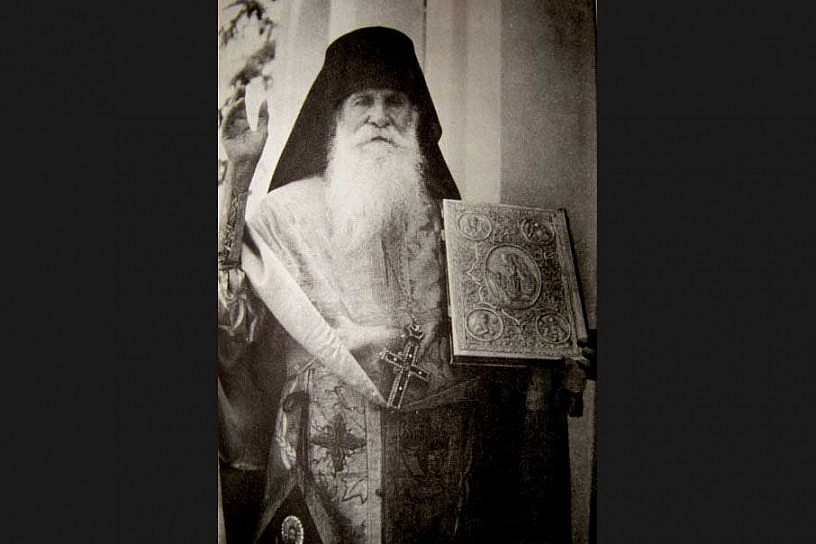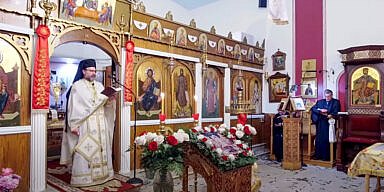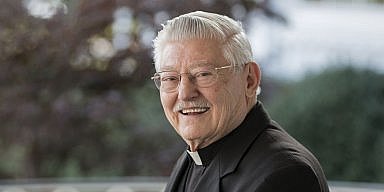Philadelphia, PA – The nieces and nephews of St. Anthimos of Chios invite you to a name day service this Sunday, February 19, 2017, at Evangelismos of Theotokos Greek Orthodox Church, 6501 Bustleton Avenue, Philadelphia.
The schedule of events are as follows: Holy Liturgy, followed by Artoklasia (9:15 am – 11:30 am). Refreshments will be served afterward in the church hall. All are welcome to attend.
Anthimos of Chios was a monastic of the twentieth century. He founded the Monastery of Panagia Voithia on the Island of Chios. Anthimos was born Argyrios K. Vagianos, on July 1, 1869, in Chios in the region of St. Luke Leivadion. His parents were devout peasants Konstantinos and Argyra Vagianos. Argyrios left elementary school early to become a shoe mender. In 1888 when he was nineteen years old, Argyrios visited the Monastery of the Holy Fathers founded by the St. Pachomios of Chios, who had been the spiritual counselor of St. Nektarios. Having received a blessing from the Elder Pachomios, Argyrios was so inspired by the monk’s divine life that on returning home he built himself a small hut, as a hermitage, and dwelt in it. The only ‘help’ Argyrios received in his spiritual contests was an icon of the Mother of God (Panagia Voithitria), which soon began to work miracles. These miracles started drawing many visitors to his hermitage.
After a time he returned to the Monastery of the Holy Fathers where he was tonsured a monk by Elder Pachomios and given the name Anthimos. However, he fell ill at the monastery, and the Elder sent him home to his parents for the sake of his health. At home in his hermitage, Anthimos continued to live as a monk, spending nights on end in prayer and sometimes living only on bread and water for extended periods of time. Despite the fact that he also was caring for his aged parents and practicing his shoe mender’s trade. Also, increasing numbers of visitors came to his hermitage and its wonder-working icon of the Theotokos. In 1909, he received the Great Schema from Hieromonk Andronikos, the successor of Elder Pachomios.
Popular with the people of Chios, they wanted him to be ordained to the priesthood. However, his bishop refused to ordain him because Anthimos lacked the necessary education. However, at the insistence of Anthimos’ godfather, the Bishop of Smyrna did ordain him. Following a pilgrimage to Mount Athos, Father Anthimos returned to Chios where he was appointed the chaplain at a leper hospital that had fallen into disarray. Under his guidance, the hospital soon became a spiritual center, as much like a monastery as a hospital. Fr. Anthimos tended many of the sickest with his hands and worked many miracles of healing. Some of his recovered patients became monks or nuns.
Following the Treaty of Lausanne of January 30, 1923, that resulted in the exchange of Greek and Turkish populations in Asia Minor and Greece, refugees poured into Chios, many of them destitute nuns and girls. During the turmoil, Fr. Anthimos had a vision of the Mother of God to build a monastery to receive the refugee nuns. Fr. Anthimos established a monastery on Chios that became, in 1930, the Monastery of Panaghia Voethia (The Virgin of Assistance), having deflected the opposition of many who said that setting up such a community was out of date. The monastery soon grew to eighty nuns and was known throughout Greece as a model of monastic life. Fr. Anthimos served as priest to the nuns. He also received a lot of visiting faithful, as many as sixty or seventy persons each day, who came to him for prayer or counsel. Fr. Anthimos carried on this ministry for more than thirty years, working many miracles of healing. When he was too old to work with his hands, he retired to his cell and prayed that he be enabled to serve his neighbor until his last breath.
Fr. Anthimos celebrated his final Divine Liturgy on January 27, 1960. He reposed in peace at the age of ninety-one on February 15, 1960, and was buried inside the church of the monastery he founded where his presence still works miracles along with the holy icon Panagia Voithia. The Ecumenical Patriarchate glorified him on August 13, 1992.



